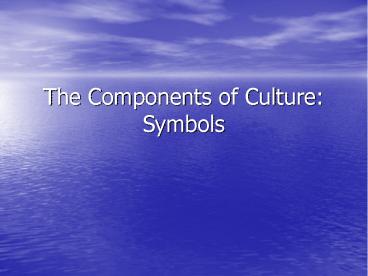The Components of Culture: Symbols - PowerPoint PPT Presentation
Title:
The Components of Culture: Symbols
Description:
The Components of Culture: Symbols Definition: A symbol is anything that represents something else. Symbols exist for countries Each of the following symbols is ... – PowerPoint PPT presentation
Number of Views:234
Avg rating:3.0/5.0
Title: The Components of Culture: Symbols
1
The Components of CultureSymbols
2
Definition
- A symbol is anything that represents something
else.
3
Symbols exist for countries
- Each of the following symbols is associated with
a particular country or region of the world. - Do you know what this is?
4
How about this?
5
Or this?
6
Do you know where this is from?
7
Or this?
8
Some symbols are widely recognized
9
Others are common, but not global.
10
Do you think someone who wasnt an American
would understand these?
11
Do you, as an American, know what these symbols
represent?
12
Remember that the same symbol is rarely used
globally.
- For example, an American might say that this is a
symbol of prestige
13
But in other parts of the world, these are also
prestige symbols.
How might these be signs of prestige?
14
Even a person can be a symbol.
15
Sometimes a symbol seems simple enough, such as a
flag.
What does this flag represent?
16
But even one symbol can have several different
meanings.
- Sometimes
- it
- depends
- on the
- situation
- in which
- the symbol
- is used.
17
What do these flags symbolize?
18
Symbols can also be controversial.
19
Why might this symbol be contested around the
world?
What does this symbol represent?
20
Gestures are another type of symbol.
- How many gestures do you know for the following
ideas? - We won!
- Youre late!
- Go away.
- Im full.
21
What ideas are being communicated by these
gestures?
Do you think these mean the same thing
in all places?
22
To Summarize
- Symbols represent something else.
- A symbol can be a sign, a place, a gesture, or
even a person. - A symbol can be local, regional, national, or
international. - Each culture has its own unique symbols.
- Symbols are often controversial.































